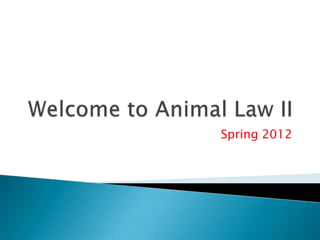
2012 - Progress
- 1. Spring 2012
- 2. The Year in Review and What’s Ahead
- 3. Thanks to a concerted lobbying push by The HSUS and HSLF and its supporters…
- 4. As the first year of the 112th Congress draws to a close, let’s take stock of how animal protection fared in 2011.
- 6. Deficit reduction was the theme this year. Nevertheless, thanks to a concerted lobbying push by The HSUS and HSLF and its supporters, Congress approved some record-level boosts for key animal welfare programs in fiscal year 2012:
- 7. Almost a 20 percent jump (more than $5 million increase) in the U.S. Department of Agriculture’s annual budget to strengthen inspections and enforcement of the Animal Welfare Act at about 12,000 sites, including puppy mills, laboratories, zoos, circuses, and other facilities.
- 8. A nearly 40 percent jump ($196,000 increase) for USDA’s enforcement of the Horse Protection Act, which had been stuck at the inadequate ceiling of $500,000 since 1976. These funds will help USDA crack down on the cruel and illegal practice of “soring” show horses, the intentional use of caustic chemicals and sharp objects on horses’ hooves and legs to make it painful for them to step down and give them an artificial, high-stepping gait in show competitions—in other words, deliberate infliction of severe pain in order to cheat and win prizes.
- 9. A 17 percent jump ($2.32 million increase) for USDA’s Investigative and Enforcement Services, which does follow-up work on a range of cases including those under the
- 10. Maintaining $4.8 million (same as last year) for the veterinary student loan forgiveness program that helps ease the shortage of veterinarians practicing in rural areas and in government positions (such as those overseeing humane slaughter and Animal Welfare Act rules), by forgiving student debt for those who choose to practice in one of those underserved areas.
- 11. At least $20 million to help ensure implementation of labor and environmental provisions—including for wildlife protection programs—under free trade agreements with countries of Central America, Peru, and the Dominican Republic.
- 12. Thanks to the work of the Center for Biological Diversity and others, $4 million to study and combat white-nose syndrome, a lethal disease that has had a devastating impact on millions of bats in North America.
- 13. In addition to funding animal welfare programs, the appropriations committees also included helpful report language directing the federal agencies and expressing concern about a number of important issues.
- 14. Humane Slaughter —directing USDA to ensure that funds intended to strengthen oversight of humane handling rules are being used that way. (Appropriations Committee Reports)
- 15. Animal Fighting —expressing strong concern and urging USDA to work with relevant agencies to investigate and enforce laws against dogfighting and cockfighting.
- 16. Antibiotics in Animal Agriculture —urging the Food and Drug Administration to take several specific actions to move forward on addressing the overuse of antibiotics in livestock for non-therapeutic purposes, a common practice on factory farms. Sen. Dianne Feinstein, D-Calif., and Rep. Louise Slaughter, D-N.Y., led efforts on this.
- 17. Pet Theft for Research—directing the National Institutes of Health to expedite its phase-out of Class B dealer-acquired dogs and cats in research (such dealers obtain animals through random sources, which can include theft of family pets and fraudulent response to “free to good home” ads). Sen. Tom Harkin, D-Iowa, played the key role on this.
- 18. Alternatives Development—requiring the NIH to prioritize funding for transition to computational, molecular and other non-animal tests for chemical risk assessment and drug testing, and report to Congress on progress; also requiring the Environmental Protection Agency to move to computational toxicology and other non-animal testing for the Endocrine Disruptor Screening Program. Rep. Ken Calvert, R-Calif., and Sen. Harkin championed these efforts.
- 19. As part of the final funding bill for USDA, Congress agreed to prohibit agribusiness subsidy direct payments to millionaires (individuals or legal entities with an average Adjusted Gross Income in excess of $1 million). Sen. Tom Coburn, R-Okla., offered an amendment that was approved by an overwhelming 84-15 vote.
- 20. An anti-wildlife rider (“extinction rider”) would have prevented the U.S. Fish and Wildlife Service from implementing some of the most crucial sections of the Endangered Species Act, such as protecting any new species and designating critical habitat for currently listed species.
- 21. The final funding bill for the Interior Department contained a provision barring the Bureau of Land Management from killing healthy, unadopted wild horses and burros or selling them for slaughter, as in past years.
- 22. The Senate’s Defense Department authorization bill would have inadvertently eliminated a prohibition in the Uniform Code of Military Justice against acts of bestiality by service members, as the Senate dealt with the repeal of the “Don’t Ask, Don’t Tell” policy. After we contacted the key members of the House-Senate conference committee, the conferees restored the ban on bestiality.
- 23. The Army agreed to halt testing on monkeys of nerve agents meant to simulate a nerve gas attack, as urged by Rep. Roscoe Bartlett, R-Md.
- 24. For Friday: Setbacks and Key Issues Ahead Assignment: (1) Review Class Site (2) Read PowerPoint on Who is Responsible for Animals under New York Issues. This should be review to you from Animal Law I.
Notes de l'éditeur
- Massive factory farms, which thrive on taxpayer giveaways that keep animal feed artificially cheap, jeopardize public health, the environment and animal welfare, while also driving smaller and more humane, sustainable family farms out of business. Let’s hope Congress will enact further reforms to end wasteful handouts that support factory farms.